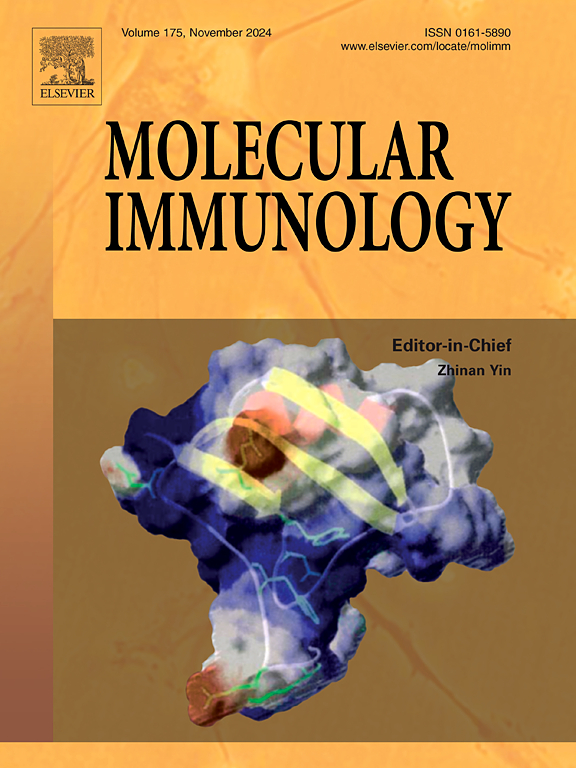鸡感染加利利蛔虫期间,通过大肠杆菌接种或几丁质饲料补充来训练先天免疫的适应症
IF 3
3区 医学
Q2 BIOCHEMISTRY & MOLECULAR BIOLOGY
引用次数: 0
摘要
胃肠蛔虫加利蛔虫的感染,在蛋鸡养殖中造成健康问题和经济损失,特别是在有机和自由放养系统中。本研究旨在评估通过在饲料中添加减毒大肠杆菌活疫苗或几丁质来诱导训练先天免疫,作为一种减轻甲状芽肿杆菌感染的新方法。该研究包括四组鸡:几丁质喂养(1 - 7日龄),大肠杆菌接种(1日龄),未经治疗的对照组和naïve未感染组。第7天龄时,前3组均感染了大肠杆菌。在初始治疗后和寄生虫感染后评估免疫参数。同时监测感染后线虫卵的粪便排泄和线虫总负荷。几丁质和大肠杆菌处理可引起骨髓白细胞比例的改变和细胞表面受体表达的改变。此外,治疗还改变了对鸡链球菌感染的免疫反应,例如观察循环中嗜白细胞和TCRγδ+CD8- t细胞的数量,以及循环白细胞亚群中细胞表面受体CD41/61、Bu-1和MHC-II的表达水平。然而,这两种处理都不影响蠕虫负荷、粪卵排泄或诱导大肠杆菌特异性IgY。这一结果显示了禽类先天免疫系统在体内训练的潜力,但需要进一步的研究来确定策略,以探索与线虫感染控制有关的策略。本文章由计算机程序翻译,如有差异,请以英文原文为准。
Indications of trained innate immunity by Escherichia coli vaccination or chitin feed supplementation assessed during Ascaridia galli infection in chickens
Infections with the gastrointestinal roundworm Ascaridia galli, cause health problems and economic losses in laying hen husbandry, particularly in organic and free-range systems. This study aimed to evaluate induction of trained innate immunity through priming with a live attenuated Escherichia coli vaccine or chitin supplementation in the feed as a novel approach to mitigate A. galli infection. The study comprised four groups of chickens: chitin-fed (day 1–7 of age), E. coli-vaccinated (day 1 of age), an untreated control group, and a naïve uninfected group. On day 7 of age, the first three groups were infected with A. galli. Immune parameters were assessed after initial treatments and post the parasite infection. Also, faecal excretion of nematode eggs and total worm burden were monitored post-infection. The chitin and E. coli treatments induced changed proportions of leukocytes in bone marrow as well as changes in cell surface receptor expression. Moreover, treatments altered the immune response to the A. galli infection, e.g. observed for numbers of heterophils and TCRγδ+CD8- T-cells in the circulation but also expression levels of cell surface receptors CD41/61, Bu-1 and MHC-II on circulating leukocyte subsets. However, neither treatment affected worm burden, faecal egg excretion or the induction of A. galli-specific IgY. The results demonstrate potential in vivo training of the avian innate immune system but further research is needed to identify strategies to explore this in relation to control of nematode infections.
求助全文
通过发布文献求助,成功后即可免费获取论文全文。
去求助
来源期刊

Molecular immunology
医学-免疫学
CiteScore
6.90
自引率
2.80%
发文量
324
审稿时长
50 days
期刊介绍:
Molecular Immunology publishes original articles, reviews and commentaries on all areas of immunology, with a particular focus on description of cellular, biochemical or genetic mechanisms underlying immunological phenomena. Studies on all model organisms, from invertebrates to humans, are suitable. Examples include, but are not restricted to:
Infection, autoimmunity, transplantation, immunodeficiencies, inflammation and tumor immunology
Mechanisms of induction, regulation and termination of innate and adaptive immunity
Intercellular communication, cooperation and regulation
Intracellular mechanisms of immunity (endocytosis, protein trafficking, pathogen recognition, antigen presentation, etc)
Mechanisms of action of the cells and molecules of the immune system
Structural analysis
Development of the immune system
Comparative immunology and evolution of the immune system
"Omics" studies and bioinformatics
Vaccines, biotechnology and therapeutic manipulation of the immune system (therapeutic antibodies, cytokines, cellular therapies, etc)
Technical developments.
 求助内容:
求助内容: 应助结果提醒方式:
应助结果提醒方式:


